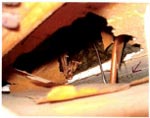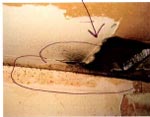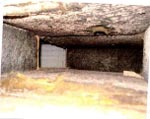
Indoor Air Quality is Nothing to Wheeze At

A hole, which was covered by cardboard, leading to my unit's inaccessible attic.
When I moved to Texas after graduating from Ohio University in July 2008, I was excited to be living in a place that had an average of 153 sunny days per year. My apartment was a recent graduate's dream: dual-level loft with new appliances and most utilities included. But when I fell ill with severe bronchitis two months later, the perfect apartment became my immune system's worst nightmare, even if I didn't know it yet.
When my eyes began to water and my nose started clogging up, I blamed Dallas' reputation for being the allergy capital of the world. And when I got the flu twice, I thought it was my body getting used to working in an office environment. But when I got pneumonia in May 2009, I knew what was causing these infections had to be something that only I was being exposed to.
Unfortunately, summer came around and I got better, spending most of my days outside and thinking that my immune system had finally adjusted to Dallas. It wasn't until a chronic sinus infection developed on the left side of my face in October did I realize that my apartment was making me sick.
After moderating an Indoor Air Quality webinar for ohsonline and getting a recommendation from a friend, I ordered an indoor air quality test for my apartment. And the results were bad.
You may be asking why it took so long for me to get an indoor air quality test. Unfortunately, residential indoor air quality is fairly unregulated. For example, when I called the Environmental Health Department in Austin, the only indoor air quality-related information the official could give me was that a home cannot have more than 25 continuous square feet of mold inside its walls. Everything else, from the types of materials used to how a home is properly ventilated, is up to the builders.
Before performing any tests, my indoor air quality specialist walked around the apartment and found numerous cracks on my walls, ceiling, and under my sink. He even pointed out that my non-sliding sliding door had been installed backward (hence, his ability to shove a $20 bill through it).

Black mold spores growing around another hole in my ceiling.
However, the magnitude of the problem wasn't apparent until he opened the access panel above my shower, revealing a number of gaping holes, some of which were surrounded by colonies of little black mold spores. And when he opened the air duct that blew air right above my bed, it was completely black.
The specialist performed a number of tests, including measuring my apartment's relative humidity (normal). To measure the airtightness of the apartment, he used a blower door to locate all air leakage sites. The test revealed I had 1735 cfm (cubic feet per minute)@50 pascals versus an acceptable reading of 996 cfm@50 Pa for a unit my size.

Inside the supply duct that blows air over my bed.
To directly pressure test my apartment's duct system, he sealed the air ducts, connected a duct blaster fan to my return air grille, turned it on, and increased the fan speed until he could standardize the pressure to 0. Unfortunately, he could never get the pressure gauge to fall under 8.4. The final results were 782 cfm@25 Pa versus 60-100 cfm@25 Pa for a unit my size.
After my apartment failed its IAQ test, I realized that it was the primary reason I was wheezing, coughing, and sniffling my way through my first year-and-a-half out of college.
EPA has an entire section dedicated to indoor air quality, and it's definitely worth a look, especially if you've been wheezing and coughing more than usual.
Have any indoor air quality nightmare stories? Tell me about them in the comments.
Posted by Carla Saavedra on Apr 02, 2010